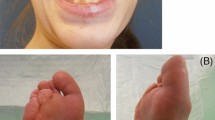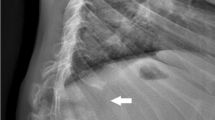Abstract
Objective
To describe the bone imaging features of lipodystrophies in the largest cohort ever published.
Materials and Methods
We retrospectively examined bone imaging data in 24 patients with lipodystrophic syndromes. Twenty-two had genetic lipodystrophy: 12/22 familial partial lipodystrophy (FPLD) and 10/22 congenital generalized lipodystrophy (CGL), 8 with AGPAT2-linked CGL1 and 2 with seipin-linked CGL2. Two patients had acquired generalized lipodystrophy (AGL) in a context of non-specific autoimmune disorders. Skeletal radiographs were available for all patients, with radiographic follow-up for two. Four patients with CGL1 underwent MRI, and two of them also underwent CT.
Results
Patients with FPLD showed non-specific degenerative radiographic abnormalities. Conversely, CGL patients showed three types of specific radiographic alterations: diffuse osteosclerosis (in 7 patients, 6 with CGL1 and 1 with CGL2), well-defined osteolytic lesions sparing the axial skeleton (7 CGL1 and 1 CGL2), and pseudo-osteopoikilosis (4 CGL1). Pseudo-osteopoikilosis was the sole bone abnormality observed in one of the two patients with AGL. Osteolytic lesions showed homogeneous low signal intensity (SI) on T1-weighted and high SI on T2-weighted MR images. Most of them were asymptomatic, although one osteolytic lesion resulted in a spontaneous knee fracture and secondary osteoarthritis in a patient with CGL1. MRI also showed diffuse fatty bone marrow alterations in patients with CGL1, with intermediate T1 and high T2 SI, notably in radiographically normal areas.
Conclusions
The three types of peculiar imaging bone abnormalities observed in generalized lipodystrophic syndromes (diffuse osteosclerosis, lytic lesions and/or pseudo-osteopoikilosis) may help clinicians with an early diagnosis in pauci-symptomatic patients.












Similar content being viewed by others
References
Robbins AL, Savage DB. The genetics of lipid storage and human lipodystrophies. Trends Mol Med. 2015;21(7):433–8.
Agarwal AK, Arioglu E, de Almeida S, et al. AGPAT2 is mutated in congenital generalized lipodystrophy linked to chromosome 9q34. Nat Genet. 2002;31(1):21–3.
Magré J, Delépine M, Khallouf E, et al. Identification of the gene altered in Berardinelli-Seip congenital lipodystrophy on chromosome 11q13. Nat Genet. 2001;28(4):365–70.
Shackleton S, Lloyd DJ, Jackson SN, et al. LMNA, encoding lamin A/C, is mutated in partial lipodystrophy. Nat Genet. 2000;24(2):153–6.
Barroso I, Gurnell M, Crowley VEF, et al. Dominant negative mutations in human PPARγ associated with severe insulin resistance, diabetes mellitus and hypertension. Nature. 1999;402(6764):880–3.
Gandotra S, Le Dour C, Bottomley W, et al. Perilipin deficiency and autosomal dominant partial lipodystrophy. N Engl J Med. 2011;364(8):740–8.
Savage DB, Semple RK, Clatworthy MR, et al. Complement abnormalities in acquired lipodystrophy revisited. J Clin Endocrinol Metab. 2009;94(1):10–6.
Vatier C, Bidault G, Briand N, et al. What the genetics of lipodystrophy can teach us about insulin resistance and diabetes. Curr Diab Rep. 2013;13(6):757–67.
Güell-González JR, De Acosta O, Alavez-Martín E, et al. O. Bone lesions in congenital generalised lipodystrophy. Lancet. 1971;298(7715):104–5.
Fleckenstein JL, Garg A, Bonte FJ, et al. The skeleton in congenital, generalized lipodystrophy: evaluation using whole-body radiographic surveys, magnetic resonance imaging and technetium-99m bone scintigraphy. Skelet Radiol. 1992;21(6):381–6.
Kaplan PA, Dussault RG, Buchanan PK, et al. Musculoskeletal case of the day. Congenital lipoatrophic diabetes. AJR Am J Roentgenol. 1996;167(1):252–3.
Sebrechts C, Garvey WT, Sartoris DJ, et al. Case report 417. Skelet Radiol. 1987;16(4):320–3.
Shinya T, Sato S, Akaki S, et al. Computed tomography findings of congenital generalized lipodystrophy: multiple nodular fatty liver and diffuse sclerosis of bones. Radiat Med. 2007;25(9):484–7.
Westvik J. Radiological features in generalized lipodystrophy. Acta Paediatr. 1996;85(s413):44–51.
Zufferey P, Laredo JD. Serous transformation of marrow of distal femoral epiphysis in a patient with congenital general lipodystrophy and spondylarthritis. Jt Bone Spine Rev Rhum. 2013;80(6):666.
Lodwick GS, Wilson AJ, Farrell C, et al. Determining growth rates of focal lesions of bone from radiographs. Radiology. 1980;134(3):577–83.
Laredo JD. The diagnosis of localized osteolysis-. Ann Radiol (Paris). 1997;40(2):107–20.
Garg A, Peshock RM, Fleckenstein JL. Adipose tissue distribution pattern in patients with familial partial lipodystrophy (Dunnigan Variety) 1. J Clin Endocrinol Metab. 1999;84(1):170–4.
Simha V, Garg A. Phenotypic heterogeneity in body fat distribution in patients with congenital generalized lipodystrophy caused by mutations in the AGPAT2 or seipin genes. J Clin Endocrinol Metab. 2003;88(11):5433–7.
Miranda DM, Wajchenberg BL, Calsolari MR, et al. Novel mutations of the BSCL2 and AGPAT2 genes in 10 families with Berardinelli-Seip congenital generalized lipodystrophy syndrome. Clin Endocrinol (Oxf). 2009;71(4):512–7.
Scheller EL, Rosen CJ. What’s the matter with MAT? Marrow adipose tissue, metabolism, and skeletal health. Ann N Y Acad Sci. 2014;1311(1):14–30.
Gregory JM, Arkader A, Bothari A, et al. Case report: unicameral bone cysts in a young patient with acquired generalized lipodystrophy. Clin Orthop Relat Res. 2010;468(5):1440–6.
Vande Berg BC, Malghem J, Lecouvet FE, et al. Distribution of serouslike bone marrow changes in the lower limbs of patients with anorexia nervosa: predominant involvement of the distal extremities. AJR Am J Roentgenol. 1996;166(3):621–5.
Böhm J. Gelatinous transformation of the bone marrow: the spectrum of underlying diseases. Am J Surg Pathol. 2000;24(1):56–65.
Wilson DE, Chan I-F, Stevenson KB, et al. Eucaloric substitution of medium chain triglycerides for dietary long chain fatty acids in acquired total lipodystrophy: effects on hyperlipoproteinemia and endogenous insulin resistance*. J Clin Endocrinol Metab. 1983;57(3):517–23.
Brunzell JD, Shankle SW, Bethune JE. Congenital generalized lipodystrophy accompanied by cystic angiomatosis. Ann Intern Med. 1968;69(3):501–16.
Haque WA, Shimomura I, Matsuzawa Y, et al. Serum adiponectin and leptin levels in patients with lipodystrophies. J Clin Endocrinol Metab. 2002;87(5):2395.
Zhou BO, Yue R, Murphy MM, et al. Leptin-receptor-expressing mesenchymal stromal cells represent the main source of bone formed by adult bone marrow. Cell Stem Cell. 2014;15(2):154–68.
Clemens TL, Karsenty G. The osteoblast: an insulin target cell controlling glucose homeostasis. J Bone Miner Res. 2011;26(4):677–80.
Caron M, Auclair M, Donadille B, et al. Human lipodystrophies linked to mutations in A-type lamins and to HIV protease inhibitor therapy are both associated with prelamin A accumulation, oxidative stress and premature cellular senescence. Cell Death Differ. 2007;14(10):1759–67.
Author information
Authors and Affiliations
Corresponding author
Ethics declarations
Competing interest
None of the authors have any competing interests in the manuscript.
Ethical approval
All procedures performed in studies involving human participants were in accordance with the ethical standards of the institutional and/or national research committee and with the 1964 Helsinki declaration and its later amendments or comparable ethical standards.
Electronic supplementary material
Below is the link to the electronic supplementary material.
ESM 1
(DOCX 53 kb)
Rights and permissions
About this article
Cite this article
Teboul-Coré, S., Rey-Jouvin, C., Miquel, A. et al. Bone imaging findings in genetic and acquired lipodystrophic syndromes: an imaging study of 24 cases. Skeletal Radiol 45, 1495–1506 (2016). https://doi.org/10.1007/s00256-016-2457-9
Received:
Revised:
Accepted:
Published:
Issue Date:
DOI: https://doi.org/10.1007/s00256-016-2457-9




